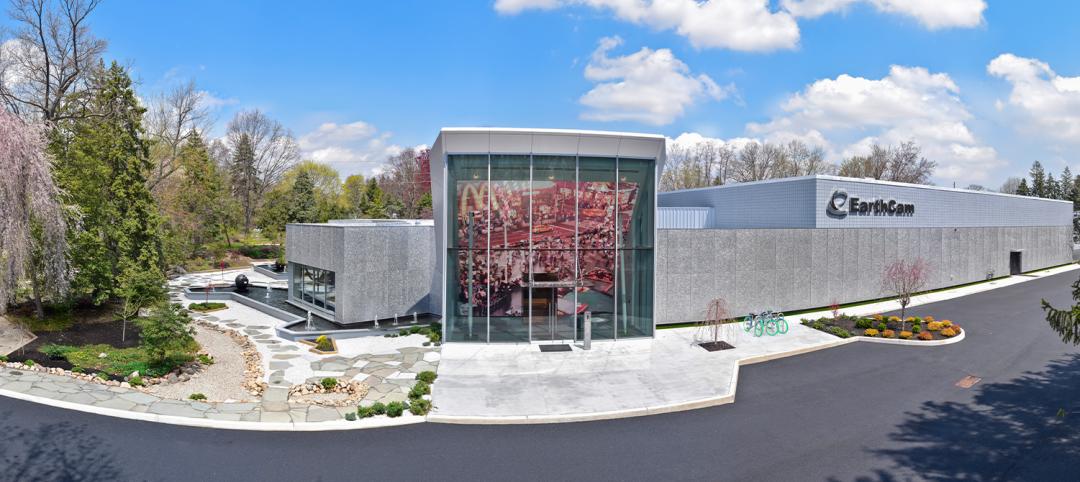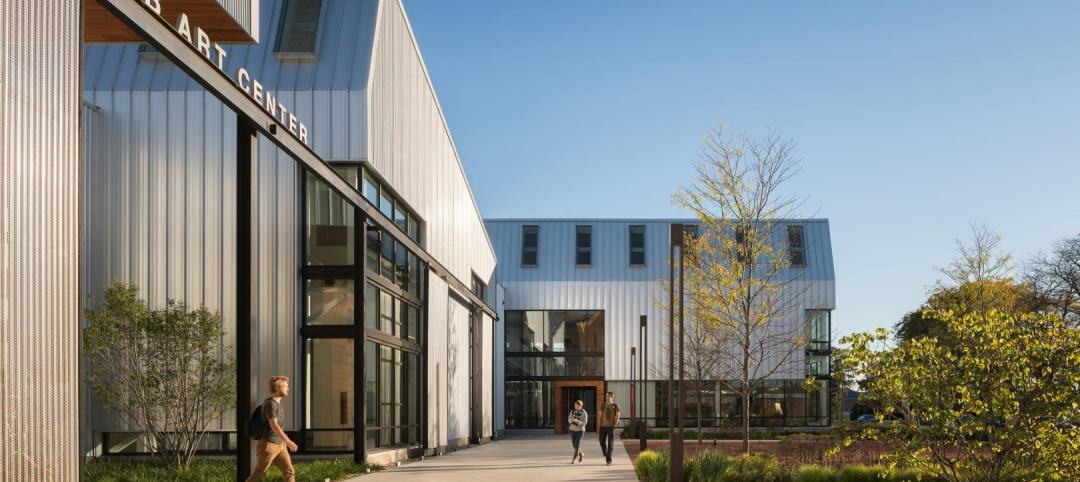Burns & McDonnell, which ranked third among Engineering/Architecture firms on BD+C’s 2018 Giants list, is launching an ambitious growth campaign that includes hiring at least 1,000 employees annually “for the foreseeable future,” and increasing the size of its World Headquarters in Kansas City, Mo., by 22%.
By year’s end, Burns & McDonnell expects to have 6,650 employees, more than half of whom will be working outside of Kansas City. The company has 11 regional offices in North America, and seven offices scattered across Europe, Africa, Asia, and the Middle East.
A 142,000-sf addition to its headquarters, which the firm is designing and building, is scheduled for completion by the summer of 2020. The company’s existing four-story 310,000-sf headquarters building opened in 2016 on a 34-acre campus in South Kansas City.
The $42 million new construction project is expected to commence in a week or two, beginning with a 550-slot parking garage, according to Brittany Swartz, a project manager in the firm’s Commercial Architecture group. The headquarters expansion will include 42 conference rooms, two large training rooms, and 780 work spaces.
Burns & McDonnell reported nearly $3 billion in revenue generated in 2017, of which $290.2 million derived from services provided for nonresidential building in several sectors that include commercial, retail, institutional, aviation, military, and manufacturing.
The firm is expanding to provide “full service solutions” for project owners that are seeking greater scheduling and budgeting certainty. Ray Kowalik, a 31-year company veteran who was named its CEO and chairman last year, adds that Burns & McDonnell had been growing and a 10-12% annual clip, which he believes can be boosted to 15%.
He cites four trends that are driving growth:
•A robust economy, favorable corporate tax law changes, and low energy prices, all of which are spurring investments in the U.S., especially in the chemicals market which is one of the firm’s largest sectors;
•The shift toward natural gas and renewable energy production that’s creating opportunities in the transmission, distribution, and generation markets;
•Greater government investment in resilience to secure and modernize aging facilities; and
•Mushrooming airport passenger traffic, and the need to find new ways to alleviate congestion at domestic and foreign terminals.
Burns & McDonnell shouldn’t have too much trouble meeting its hiring goals: it receives about 80,000 resumes per year, and the company has already hired 1,000 people in 2018, as of today’s announcement. It expects its hiring number to top out at 1,400 this year. “We’re a company that a lot of people want to work for,” says Kowalik. (In prior years, the company would typically offer employment to between 300 and 400 people, with 90% of applicants accepting.)
Kowalik says Burns & McDonnell already has a pretty good system in place for assimilating new hires, which includes extensive training and mentoring. (He said the company’s attrition rate is about 5% annually.)
While the power, gas, oil, and chemicals sectors are among the markets driving growth, Kowalik says his company is also expanding its nonresidential building activities, notably in the areas of office and multitenant apartment construction. “We’re extremely busy in Kansas City,” he says, having recently completed a new office building there for Creative Planning, a local wealth-management firm.
Kowalik adds that new tax policy is sparking “multibillion-dollar projects” in the chemicals industry, which are likely to trigger new commercial construction that supports that business. He expects a similar “trickle down” effect from oil and gas.
Historically, Burns & McDonnell has grown organically, “one employee at a time,” says Kowalik. But in recent years it has bolstered its presence on the construction side with acquisitions of two contractors, AZCO Inc. in Wisconsin and Ref-Chem in Texas.
Kowalik says that it’s possible that his company might seek out joint-venture construction partners. But he hedged about future acquisitions. “The minute I say ‘we’re interested,’ we get 20 calls.”
He is concerned, though, about the skilled-labor shortage, and thinks the AEC industry needs to take a more active role in outreach and training.
Related Stories
Mixed-Use | Apr 26, 2022
Downtown Phoenix to get hundreds of residential and student housing units
In fast-growing Phoenix, Arizona, a transit-oriented development called Central Station will sit adjacent to Arizona State University’s Downtown Phoenix campus.
Hotel Facilities | Apr 25, 2022
U.S. hotel construction pipeline up 2%, with 5,090 projects in the works
The total U.S. hotel construction pipeline stands at 5,090 projects and 606,302 rooms at the end of the first quarter of 2022, up 2% by projects, but down 3% by rooms, according to the Q1 2022 Construction Pipeline Trend Report for the United States from Lodging Econometrics (LE).
Codes and Standards | Apr 25, 2022
Supply chain constraints, shifting consumer demands adding cost pressures to office fit-outs
Cushman & Wakefield’s 2022 Americas Office Fit-Out Cost Guide found supply chain constraints and shifting consumer demands will continue to add pressure to costs, both in materials and labor.
Sports and Recreational Facilities | Apr 25, 2022
Iowa's Field of Dreams to get boutique hotel, new baseball fields
A decade ago, Go the Distance Baseball formed to preserve the Iowa farm site where the 1989 movie Field of Dreams was filmed.
Building Team | Apr 22, 2022
EarthCam Adds Senior Leadership Roles to Facilitate Rapid Growth
EarthCam today announced several new leadership positions as it scales up to accommodate increasing demand for its webcam technology and services.
Architects | Apr 22, 2022
Top 10 green building projects for 2022
The American Institute of Architects' Committee on the Environment (COTE) has announced its COTE Top Ten Awards for significant achievements in advancing climate action.
Mixed-Use | Apr 22, 2022
San Francisco replaces a waterfront parking lot with a new neighborhood
A parking lot on San Francisco’s waterfront is transforming into Mission Rock—a new neighborhood featuring rental units, offices, parks, open spaces, retail, and parking.
Legislation | Apr 21, 2022
NIMBYism in the Sunbelt stymies new apartment development
Population growth in Sunbelt metro areas is driving demand for new apartment development, but resistance is growing against these projects.
Building Team | Apr 20, 2022
White House works with state, local governments to bolster building performance standards
The former head of the U.S. Green Building Council says the Biden Administration’s formation of the National Building Performance Standards Coalition is a “tremendous” step in the right direction to raise building performance standards in the U.S.
Market Data | Apr 20, 2022
Pace of demand for design services rapidly accelerates
Demand for design services in March expanded sharply from February according to a new report today from The American Institute of Architects (AIA).

















